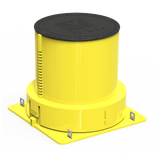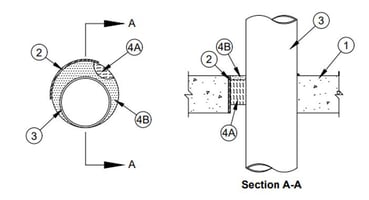In this issue:
STI News
Sleeves are commonly used in concrete floors. Sometimes the sleeve is a form to create an opening for a penetrating item. Other times, the sleeve may project beyond the top surface of the floor to help deflect or prevent entry of water. Sleeves can be metal or plastic.
Sleeves can impact how firestopping systems are applied. The UL System will always specify the requirements of the sleeve such as the material composition, the thickness, the maximum diameter, the distance above the floor the sleeve can project (if allowed), and whether the sleeve is optional or required. When reading a UL System, the sleeve will typically be described immediately following the construction of the floor assembly itself.
Flush Sleeves: When a sleeve is described as flush, it means the top and bottom of the sleeve are even with the concrete surfaces. When a manufacturer tests the sleeve as flush, the sleeve is listed as optional within the system. It is generally agreed that a sleeve is more critical than an unsleeved opening due to heat conducted through a metal sleeve or a plastic sleeve that may melt where exposed to high heat and flame.
Raised Sleeves: When a sleeve is described as projecting a given distance above the floor slab, it will often list this dimension as being a maximum. Therefore, a sleeve projection below the maximum height specified is acceptable. Most of these systems may specify the positioning of the fill and packing materials (i.e. firestop caulk and mineral wool packing). When the sleeve height is greater than specified in the system, sometimes an engineering judgment firestop system may be obtained. Those systems sometimes specify that the depth of packing material be increased as required to ensure that the bottom of the packing material is at the same location as the packing material position in the base system being referenced.
Nonmetallic Sleeves: Some UL Systems feature plastic pipes used as sleeves. Still others may feature the use of thin-wall molded plastic sleeves used as concrete forms. In the case of nonmetallic pipes, the UL System will describe the pipe diameter, the pipe type, and the wall thickness. For thin-wall concrete forms, it will specify the composition of the plastic and other details such as whether the sleeve is tapered. These are important distinctions. If a tapered sleeve is used, it could have more pronounced annular space that could impact firestop system performance, so it is important to verify that the system permits the use of that type of sleeve. It is a common misconception to think that a plastic sleeve will melt through the floor. Testing has shown how these types of sleeves can be used in concrete floors.
Sheet Metal Sleeves: Increasingly, lighter gauge steel sleeves that are provided with features to embed within the concrete are being used. In general, testing has shown that these types of sleeves perform comparably to steel pipe sleeves. However, the system should list the sheet metal sleeve in question as an option.
Cast-In-Devices: Cast-in-devices are a version of a sleeve system that happen to integrate a firestop system. So they act as a form to run penetrants, but also contain a built-in fire and smoke sealing system. In the case of cast-in-devices, the device will be listed as a “firestop device” and not a sleeve.
While this article provides an overview of some of the types of sleeves that can be used, it is not completely exhaustive. We urge you to discuss this with the manufacturer’s Engineering Services team to ensure compliance.



